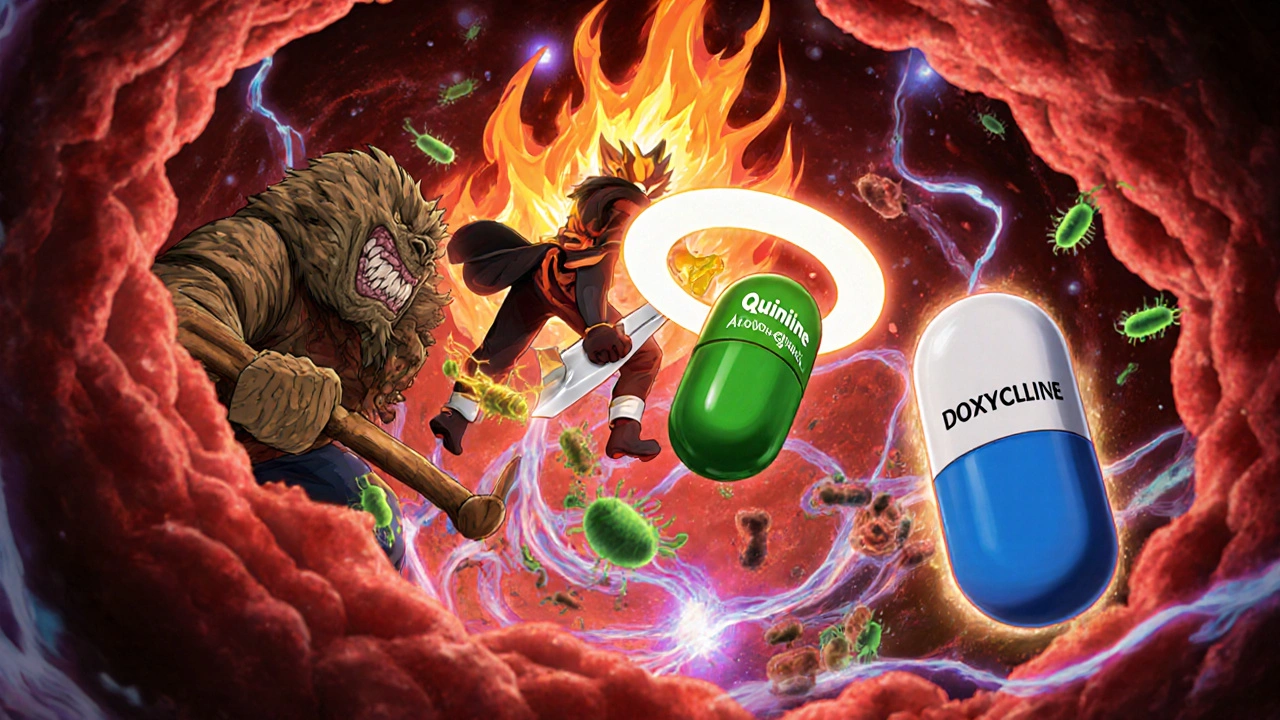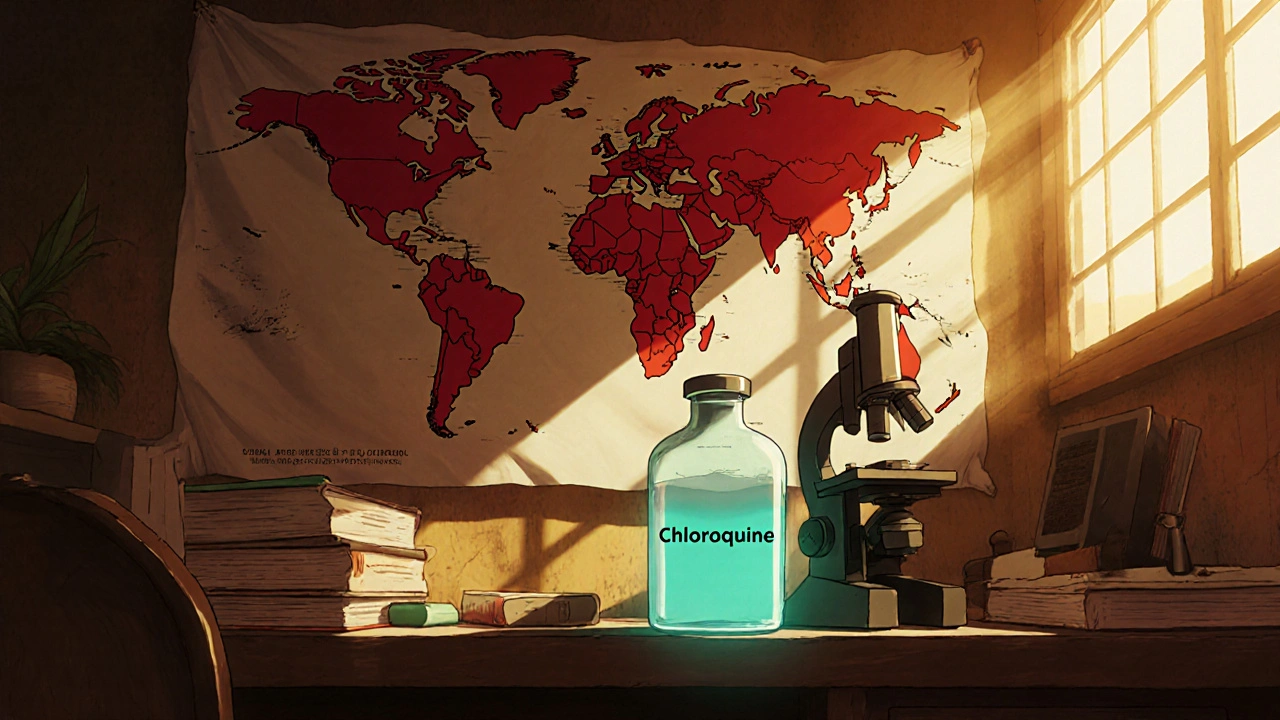Malaria Treatment Selector
Select Your Scenario
Answer these questions to get a treatment recommendation
When it comes to treating malaria and a few other conditions, chloroquine often shows up in the conversation. But the drug isn’t the only option on the shelf, and health professionals need a clear picture of how it stacks up against other medicines. This guide walks through the most common alternatives, compares how they work, where they’re used, and what safety concerns you should watch out for.
What is Chloroquine?
Chloroquine is a synthetic 4‑aminoquinoline that has been used for decades as a first‑line antimalarial and, in some cases, as an anti‑inflammatory agent. It was first introduced in the 1940s and quickly became the go‑to drug for Plasmodium falciparum infections. The medication works by interfering with the parasite’s ability to digest hemoglobin, leading to a toxic buildup of heme inside the parasite.
Typical adult dosing for uncomplicated malaria is 600 mg orally as a loading dose, followed by 300 mg after 6‑12 hours, then 300 mg daily for two more days. Because it stays in the bloodstream for a long time, a single course can provide post‑exposure prophylaxis for up to two weeks.
Why Look at Alternatives?
Resistance to chloroquine has risen dramatically in many parts of the world, especially in sub‑Saharan Africa and Southeast Asia. In regions where the parasite has developed resistance, the drug’s effectiveness drops to under 10 %. Moreover, chloroquine’s side‑effect profile-especially retinal toxicity with long‑term use-makes clinicians consider safer or more tolerable therapies.
The following sections compare the most widely used alternatives, highlighting where they shine and where they fall short.
Hydroxychloroquine
Hydroxychloroquine is a 4‑hydroxy‑chloroquine derivative with a similar mechanism of action but a better safety margin, especially for chronic use. It gained fame as a treatment for rheumatoid arthritis and lupus because it can be taken for months or years without causing the severe retinal damage seen with high‑dose chloroquine.
In malaria, hydroxychloroquine is less potent than chloroquine, so it’s generally reserved for areas where chloroquine resistance is low. Dosage for prophylaxis mirrors chloroquine (400 mg weekly after a 400 mg loading dose), but for autoimmune conditions the dose is typically 200‑400 mg daily.
Artemisinin‑Based Combination Therapies (ACTs)
Artemisinin is a sesquiterpene lactone derived from the sweet wormwood plant (Artemisia annua) that acts rapidly against malaria parasites. Because resistance to artemisinin alone can develop quickly, it is always paired with another antimalarial in an ACT.
Common ACTs include artemether‑lumefantrine (Coartem) and artesunate‑amodiaquine. These combinations clear parasites faster than chloroquine and retain high efficacy even in regions with extensive chloroquine resistance. A typical adult course lasts three days, with doses taken twice daily.
Quinine
Quinine is a natural alkaloid extracted from the bark of the cinchona tree, historically the first effective antimalarial. It works by disrupting the parasite’s ability to digest hemoglobin, similar to chloroquine, but binds to different sites.
Quinine is now a second‑line drug, used when ACTs are unavailable or contraindicated. A standard regimen for Plasmodium falciparum is 600 mg orally every 8 hours for 7 days, often combined with doxycycline or clindamycin to improve cure rates.

Atovaquone‑Proguanil (Malarone)
Atovaquone‑Proguanil is a fixed‑dose combination that blocks mitochondrial electron transport in the parasite (atovaquone) and inhibits dihydrofolate reductase (proguanil). The synergy yields high efficacy against chloroquine‑resistant strains.
It is popular for both treatment and prophylaxis because the dosing is simple-one tablet daily-and side effects are mild. However, the cost is considerably higher than chloroquine, which can limit accessibility in low‑resource settings.
Doxycycline
Doxycycline is a broad‑spectrum tetracycline antibiotic that also has antimalarial activity by inhibiting protein synthesis in the parasite. It is most often used as a prophylactic agent for travelers heading to areas with resistant malaria.
The usual prophylactic dose is 100 mg daily, started 1‑2 days before travel and continued for 4 weeks after leaving the endemic area. Doxycycline can cause photosensitivity and gastrointestinal upset, so patients need to avoid excessive sun exposure.
Side‑Effect Profiles at a Glance
| Drug | Primary Indication | Mechanism of Action | Common Side Effects | Typical Dosage |
|---|---|---|---|---|
| Chloroquine | Uncomplicated malaria (historical) | Inhibits heme polymerization | Retinal toxicity (long term), nausea, pruritus | 600 mg loading, then 300 mg daily x2 days |
| Hydroxychloroquine | Autoimmune diseases, low‑resistance malaria | Similar to chloroquine, milder retinal risk | Retinal changes (rare), GI upset | 200‑400 mg daily |
| Artemisinin‑based ACT | Resistant malaria | Rapid parasite clearance via free radical formation | Vomiting, dizziness, mild hepatic elevation | Twice daily for 3 days |
| Quinine | Severe or resistant malaria | Disrupts heme detoxification | Cinchonism (tinnitus, headache), hypoglycemia | 600 mg q8h for 7 days |
| Atovaquone‑Proguanil | Prophylaxis & treatment of resistant malaria | Blocks mitochondrial electron transport + DHFR inhibition | Abdominal pain, rash, rare hepatic effects | 1 tablet daily |
| Doxycycline | Prophylaxis for travelers | Inhibits protein synthesis | Photosensitivity, esophageal irritation | 100 mg daily |
How to Choose the Right Drug
- Assess local resistance patterns. If the region reports >50 % chloroquine resistance, skip chloroquine and opt for ACTs or atovaquone‑proguanil.
- Consider patient comorbidities. For patients with retinal disease, avoid chloroquine and hydroxychloroquine. Those with cardiac arrhythmias should steer clear of quinine due to its QT‑prolonging potential.
- Evaluate cost and accessibility. Chloroquine remains the cheapest option (often under $1 per course), whereas ACTs and atovaquone‑proguanil can cost $30‑$70 per treatment.
- Plan for prophylaxis duration. Doxycycline and atovaquone‑proguanil are convenient for long trips; chloroquine requires a loading dose that may be less practical for short stays.
- Check for drug interactions. Quinine can lower blood sugar, interfering with insulin or sulfonylureas. Doxycycline reduces efficacy of oral contraceptives.
By walking through these checkpoints, clinicians can match the drug to the patient’s situation, balancing efficacy, safety, and practicality.
Special Populations
Pregnant Women: WHO recommends ACTs as first‑line therapy in the second and third trimesters. Chloroquine and hydroxychloroquine are generally safe in the first trimester but have limited data for later stages.
Children: Dosing must be weight‑based. ACTs have pediatric formulations (dispersible tablets). Chloroquine dosing in children follows the same mg/kg rule but watch for signs of retinopathy in prolonged courses.
Elderly Patients: Reduced renal function can affect quinine clearance, increasing risk of cinchonism. Start with lower quinine doses and monitor cardiac rhythm.
Future Directions and Emerging Therapies
Research continues on new antimalarials that bypass existing resistance pathways. Tafenoquine, a single‑dose agent, shows promise for radical cure of P. vivax but still carries a risk of hemolysis in G6PD‑deficient patients. Meanwhile, combination regimens that pair a fast‑acting drug (like artemisinin) with a long‑acting partner (like piperaquine) aim to simplify treatment schedules.
Quick Reference Checklist
- Identify local chloroquine resistance rates.
- Match drug to patient’s health profile (eye, heart, liver).
- Weigh cost vs. efficacy-ACTs for high resistance, chloroquine only where cheap and effective.
- Choose prophylaxis drug based on travel length and side‑effect tolerance.
- Monitor for drug‑specific adverse events during and after therapy.
Frequently Asked Questions
Can chloroquine still be used for malaria in 2025?
Yes, but only in regions where resistance is below 10 %. Many African countries have switched to ACTs, but parts of South America and Oceania still report high chloroquine efficacy.
Is hydroxychloroquine safer than chloroquine for long‑term use?
Hydroxychloroquine has a lower risk of retinal toxicity and is the preferred choice for autoimmune diseases. However, both drugs require baseline eye exams and regular monitoring if used for more than a few weeks.
When should I prescribe atovaquone‑proguanil instead of an ACT?
Atovaquone‑proguanil is ideal for travelers who need a single‑tablet daily regimen and where cost is less of a barrier. It’s also used when ACTs are contraindicated, such as in patients with known artemisinin resistance.
What are the main side effects of quinine?
Quinine can cause cinchonism-tinnitus, dizziness, headache-as well as hypoglycemia, especially in patients on insulin. It may also prolong the QT interval, so ECG monitoring is advised for at‑risk individuals.
Is doxycycline effective for treating active malaria?
Doxycycline is primarily used for prophylaxis. In treatment, it is paired with a fast‑acting drug like quinine to improve cure rates, but on its own it does not clear parasites quickly enough.
Choosing the right antimalarial isn’t a one‑size‑fits‑all decision. By comparing chloroquine with its modern alternatives-hydroxychloroquine, ACTs, quinine, atovaquone‑proguanil, and doxycycline-you can tailor therapy to resistance patterns, patient health, and practical considerations like cost and dosing convenience.









Chloroquine is outdated in most endemic zones; stick to ACTs unless resistance is proven low.
There's a lot to consider when picking an antimalarial – cost, side‑effects, local resistance patterns, and patient preferences all matter. It helps to have a quick cheat‑sheet for clinicians on hand.
Honestly, I think the whole hype around ACTs overshadows the fact that chloroquine still works fine in many pockets of the world. Sure, resistance has crept up in sub‑Saharan Africa, but you’re not gonna see the same numbers in South America or the Pacific islands. The data shows that in places where resistance is below 20 %, chloroquine remains one of the cheapest and most effective options. People love to throw around the term “multidrug‑resistant malaria” without checking the local surveillance reports first. If a tiny village has a 5 % resistance rate, why switch to a $30‑$70 regimen that most patients can’t afford? Also, the side‑effect profile of chloroquine, while not perfect, is generally milder than that of quinine or the newer combos, especially when you limit the course to a few days. Retinal toxicity is a concern only with long‑term, high‑dose use, not a short therapeutic course. I’ve seen clinicians avoid chloroquine out of fear, yet they prescribe hydroxychloroquine for lupus patients for years without a problem. The pharmacokinetics of chloroquine actually give it a nice post‑exposure prophylaxis window that many travelers appreciate. And don’t forget – the logistics of dosing ACTs can be a nightmare in remote clinics where you don’t have refrigeration or reliable supply chains. A single loading dose of chloroquine is much easier to administer than a three‑day ACT schedule. Sure, newer drugs have their place, but dismissing chloroquine outright feels like throwing the baby out with the bathwater. At the end of the day, evidence‑based prescribing should be about matching the drug to the resistance data, not just jumping on the latest brand name.
While the enthusiasm for newer agents is understandable, it’s critical to remember that every drug has a trade‑off. Overreliance on ACTs can mask emerging resistance and drive up costs unnecessarily. Clinicians should still evaluate local data before discarding older options.
While the historical significance of chloroquine is undeniable, its pharmacokinetic profile renders it suboptimal in contemporary prophylaxis.
And yet, many still cling to the outdated notion that chloroquine is universally unsafe; the reality is far more nuanced. Its dramatic resurgence in low‑resistance zones deserves a more balanced discourse.
When you look at the bigger picture, it’s clear that the choice of antimalarial should be guided by local resistance patterns, patient comorbidities, and accessibility. Empowering clinicians with up‑to‑date regional data can make a huge difference in outcomes.
Exactly, Ben. I’ve seen frontline workers struggle with ACT supply chains, especially in remote hamlets. A simpler regimen like chloroquine-when it’s still effective-can be a lifesaver. Of course, you have to keep an eye on those resistance maps, but don’t discount practicality.
cost matters most.